Achimenes rhizomes: what is it, how to plant and store?

Ahimenes is a beautiful perennial plant that is grown in warm home conditions, as well as on verandas and balconies. It blooms for a long time, releasing a lot of cheerful, pretty inflorescences, but in winter you don't have to enjoy this flower, as it goes into "hibernation".
Description
Achimenes is home to the American continents. Since the end of the 18th century, the plant was brought to Europe from the islands of the Caribbean. In the 19th century, the flower was actively bred, and by the beginning of the 20th century, many hybrids had appeared. Nowadays, agronomists continue to work on the development of new varieties, the Romanian scientist Serge Saliba was especially successful, who bred about 200 species of this beautiful plant.
Akhimenes are perennial flowers of the Gesneriev family, with thin drooping stems, some varieties have an erect stem. For example, the only species that does not grow in America, but in South India, is endowed with just such a stem. The leaves are pubescent, with a rich color in the lower part. Single and paired inflorescences are fixed in a thin five-leaf calyx.
Ahimenes suspend their livelihoods, dying down from mid-autumn to early spring (for 4-6 months), when daylight hours become short. In this case, the ground part completely dies off. They reproduce by rhizomes, which are small scaly shoots that resemble very young spruce cones. The plant does not have underground tubers, and rhizomes, appearing on the rhizome, play the role of seeds in the reproduction process. From the end of winter to mid-spring, young shoots appear, the first harbingers of "awakening".
During the growing season, you should take care of the plant so that by the time of "hibernation" the rhizomes gain strength.

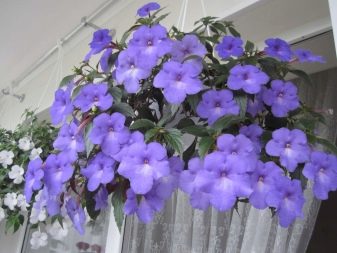
Preparing the rize for storage
With the arrival of autumn, the plant begins to prepare for winter dormancy. It stops growing, releasing buds. From the lower part of the stem, the leaves gradually wither and fall off. During this period, feeding and watering should be reduced. The plant gradually ceases to need moisture, an excess of it can lead to rotting of the rhizome and improper formation of rhizomes.
It is necessary to pay attention to temperature conditions and lighting. For a plant that stays in an apartment, it is worth looking for a cooler and darker place.
The rhizomes are considered ready for rest when the ground part has completely faded. If the overstated temperature prevents the flower from getting rid of the herbaceous part, you should completely stop watering it.
Rhizom storage in the ground
Rhizomes are stored until spring in several ways: by leaving them in pots or taking them out. If you decide to leave the plant in the ground, you should carefully rid it of the ground part, cutting it almost to the base. The pot must be moved to a dark, cool place. The optimum temperature for a dormant plant is 12-18 degrees. During this period, watering should be completely absent. Occasionally, you can slightly moisten the soil to avoid clumping and cracking.
The rhizomes of a young plant, obtained by cuttings, are too small and weak, and by spring they may not survive. They are best kept at room temperature and slightly damp.
When hibernation comes to an end it is important not to miss the moment of awakening. They learn about him during the appearance of the first shoots.During this period, you should pour some fresh earth into the pot and transfer it to a brighter place. Now you can start watering the plant, and then introduce top dressing.
Some growers, about a month before waking up, take out rhizomes from the pot, sort them out, sorting out dried specimens, and transplant healthy shoots into fresh soil. Before planting, the rhizomes are separated so that the seedlings are not heaped. Plant them shallow, otherwise the shoots will weaken. In fresh nutrient soil, the plant wakes up more actively.
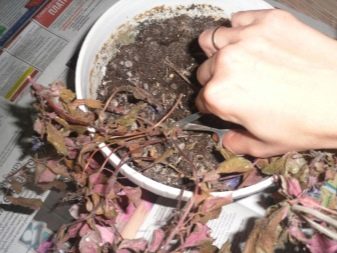

Rhizom storage outside the ground
The process of storing scaly shoots outside the ground begins in the fall, after the aerial part has completely dried. All the contents are taken out of the flower pot, the earth is shaken off, carefully freeing the rhizomes with rhizomes. Weak, diseased material should be removed, leaving only healthy specimens. If fungal diseases and rot are detected, rhizomes with scaly shoots must be processed fungicideafter removing the affected tissue.
Before sending rhizomes for storage, they should be dried at room temperature.... Then sprinkle with sand and peat and spread out in plastic bags, each tightly closed. During storage, the planting material is periodically examined; when condensate forms in the packages, the rhizomes are removed and dried. If this is not done, the plants can again infect mold and mildew. In addition, moisture can contribute to untimely germination.
The material collected in bags should be stored in the same way as the one left in pots with soil - in a cool, dark place.
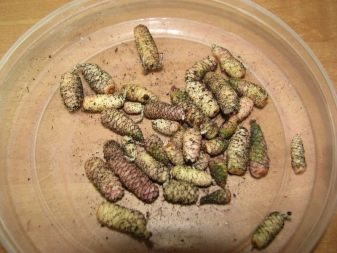
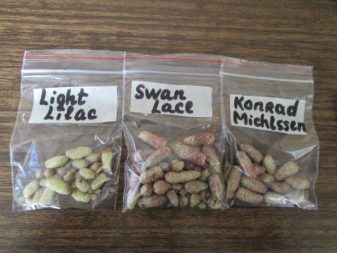
Preparing for landing
Before planting a plant, you need to make sure that it wakes up. The signal is the formation of sprouts, they can be several millimeters in size, but they already let you know that the vegetation process has begun. Even with the appearance of sprouts with planting, you can not rush, the main thing is to produce it within a month. Of course, it is better not to let the rhizomes grow too long, otherwise, they may break during the transplant. By the way, a broken specimen also germinates, but later for a few weeks.
The time of emergence of sprouts depends on many factors, so it is not strictly defined. From February to April, these are purely conditional time boundaries. If the temperature regime is violated in the direction of overheating and high humidity, Achimenes can wake up in January. A hasty awakening is also influenced by their early fall hibernation. From late asleep, young and weak plants or in the presence of low temperatures, shoots can be expected until May.
Once the sprout has begun to move, you cannot stop it. Such a process in January is completely inappropriate, it disrupts the natural biological cycle of the plant. You can try to inhibit growth by transferring the planting material to colder, drier conditions.
But long-term illumination is already necessary, otherwise a weak, thin and long sprout will form. To organize the correct lighting, you can resort to using a fluorescent lamp.
Often Achimenes are planted already sprouted, in the form of a strong, formed sprout. Sprout them in glasses, planting one rhizome in each container. To do this, moistened soil is poured into a glass, the planting material is laid in a horizontal position and sprinkled with earth with a layer of no more than 2 centimeters. You can water a little more if necessary. The glass should be transferred to a warm, bright place. In the evenings, seedlings will need additional lighting. Care must be taken to keep the soil slightly moist. Watering is necessary, about once a week.
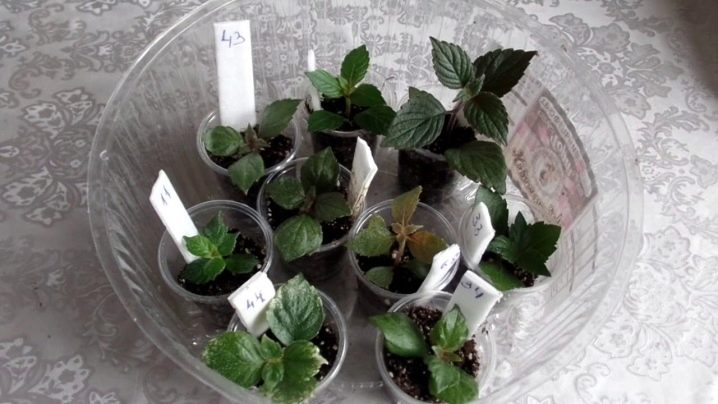
Planting a plant
A plant germinated in a glass must be planted in a pot as carefully as possible. If possible, it is best to move the flower along with the soil in which it grew. Pots are selected shallow but wide.From one to 5-7 sprouts are planted in one container, depending on the volume of the pot. For growing Achimenes in pots without prior germination, choose the same flat wide containers. A plant with superficial growth of rhizomes does not like deep planting. Rhizomes are planted as follows.
- Begin to complete the flower pot with drainage. Ahimenes do not tolerate the accumulation of dampness, drainage is necessary for them.
- Having laid out a little sand and gravel on the bottom of the container, it is covered with more than two-thirds of the earth. The soil should contain peat, be loose and moist.
- Rhizomes are laid out on the surface in a horizontal position, their number depends on the volume of the pot.
- The planting material is covered with a layer of earth of 2-3 centimeters.
- If the soil is not moist enough, lightly watered with warm water.
- The pots are transferred to a warm, bright place, covered with cellophane or glass, creating the effect of a greenhouse.
Landing is complete. Next, you need to monitor the humidity and temperature conditions. Plants grow well at a temperature of 20-27 degrees. When the Achimenes begin to rise, they will need illumination of at least 16 hours a day, in the evenings they need to leave the lamps on.
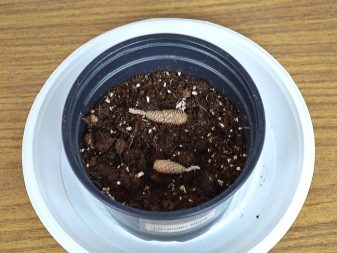

Waiting for shoots
With the standard development of events, the first shoots after planting will be in 3 weeks. Depending on the early or late planting, growers try to regulate germination using special methods. If you need to slow down growth, you should reduce the temperature environment of the plant. In order for the rhizomes to germinate more quickly, they must be watered with warm water and kept in a well-heated room.
You can use water heated to 50 degrees once, this will finally wake up the rhizomes. When sprouts appear, you need to wait until they grow a few centimeters, and add some fresh soil again. With proper care, amazingly beautiful, variegated Achimenes will delight with their flowering for more than six months.
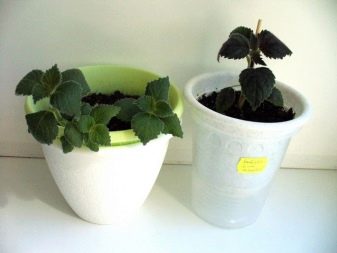


































































































The comment was sent successfully.